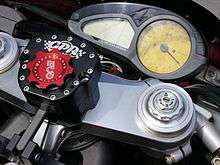Steering damper
A steering damper, or steering stabiliser is a damping device designed to inhibit an undesirable, uncontrolled movement or oscillation of a vehicle steering mechanism, a phenomenon known in motorcycling as wobble.
On motorcycles
Sport bikes have a short wheelbase and an aggressive steering geometry to provide the ability to make very quick changes in direction. This has the harmful side-effect of making the bike less stable, more prone to feedback from uneven road surfaces, and more difficult to control.[1] If the front wheel significantly deviates from the direction of travel when it touches down, it may cause an unwanted wobble. Steering dampers are factory installed on some high-end sport motorcycles and fitted to most contemporary racing bikes to counter these behaviours. Steering dampers are also mounted to off-road motorcycles such as motocross bikes.[2] A damper helps keep the bike tracking straight over difficult terrain such as ruts, rocks, and sand, and also smooths out jolts through the handlebars at the end of jumps. They also reduce arm fatigue by reducing the effort to control the handlebars.

On motorcycles, one end of the damper is mounted to the steering yoke or triple tree, the other to the frame. Two main types are linear and rotary. Linear dampers resemble a telescoping shock absorber and operate in a similar manner. They can be aligned either longitudinally and to one side of the steering, or transversely across the bike. Rotary dampers resemble small boxes and operate via a rotating pivot. They are mounted coaxially with the steering axis and are typically located on top of the steering head. An electronically variable damper uses a rotary damper with hydraulic fluid that flows freely at low speeds, allowing easy turning, while restricting flow at higher speeds when more damping is necessary, as determined by the engine control unit.[1]
For motorcycles with sidecars, especially for motorcycles which have been retrofitted with a sidecar and where the front wheel geometry, or trail, has not been adjusted for use with a sidecar, a steering damper is beneficial. This prevents low speed wobble which may occur in the lower speed range of about 13 to 20 mph. In older motorcycles adjustable friction dampers had been routinely installed. Hydraulically operated steering dampers may be retrofitted. In some jurisdictions, the installation and operation of a steering damper must be inspected by an expert or examiner and must be entered in the vehicle papers.[3][4]
On bicycles
Steering dampers have been available for bicycles as well.[5] There is also a mechanism by the same name that consists only of a spring connected to the frame and the fork that merely provides a progressive torque to straighten the steering.
Gallery
-

Electronic steering damper with control arm attached to the upper triple clamp
-

An aftermarket steering damper attached below the lower triple clamp
-

Schematic of a simple spring "steering damper" for bicycle
-
Steering spring photo
References
- 1 2 Honda Electronic Steering Damper
- ↑ Two of the best from Honda
- ↑ Bundesverband der Motorradfahrer e.V., Fourth Edition, 1988
- ↑ "Damper". Thewordunscrambler.
- ↑ "Hopey Steering Damper". Dirt Rag Magazine. 2000-10-01. Retrieved 2013-03-16.
140 grams [4.9 oz], fully hydraulic, bicycle steering damper
.